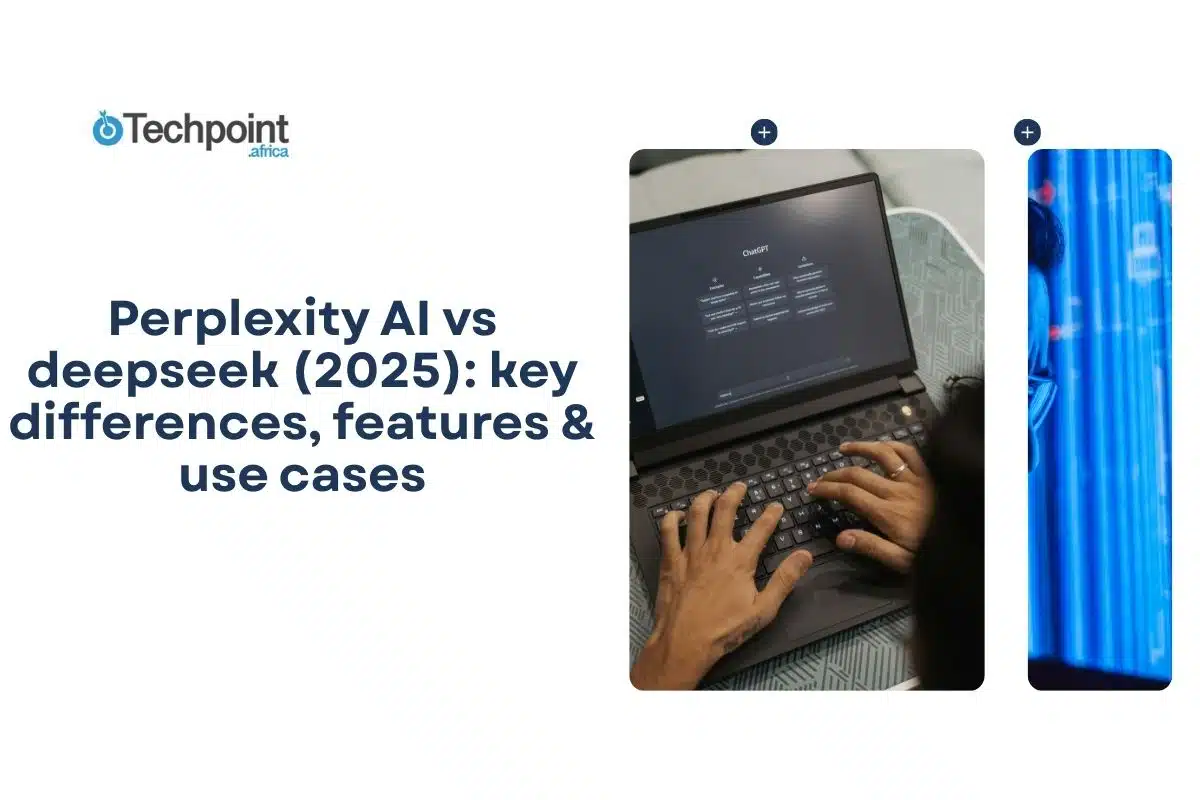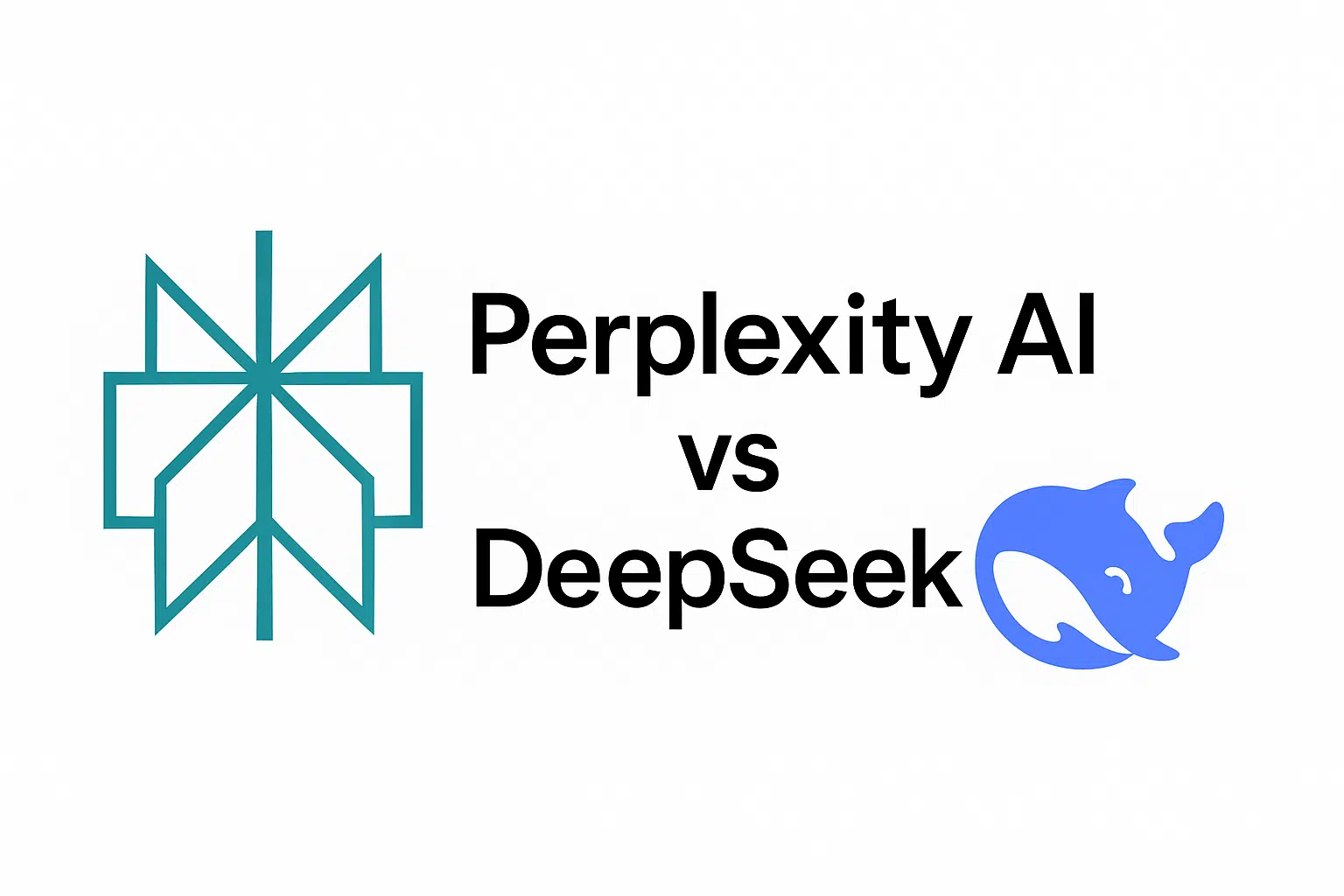
LLMs are mainly associated with text, and that is correct. But multimodal LLMs are now the order of the day since LLMs just do text stuff.
In fact, different LLMs structure their answers to the prompt differently. This is why I singled out Perplexity AI and DeepSeek from the horde: to see how they get the wheels running.
This review is a personal account of my experiences, backed with screenshots and a collection of what makes Perplexity AI and DeepSeek tick the way they do.
Let’s start!
Key takeaways on Perplexity AI vs DeepSeek
- Perplexity AI excels at research-driven queries with transparent citations, fast responses, and a minimalist UI that makes it ideal for academic and fact-based tasks.
- DeepSeek offers more substantial conversational depth with better context memory, making it more suitable for brainstorming, analytical writing, and long-form discussions.
- Perplexity AI is better at avoiding hallucinations by linking to live web sources, while DeepSeek sometimes repeats or lacks citation depth.
- DeepSeek handles multi-step reasoning more effectively, providing extended answers that build logically across long thinking sessions, unlike Perplexity, which is optimized for shorter, search-like exchanges.
- Perplexity AI prioritizes speed and clarity, but its reliance on web connectivity weakens it in offline or niche domains.
- DeepSeek exchanges speed for depth, often responding more slowly, but giving users more nuanced and flexible answers in ongoing dialogue.
- Both tools have integration limitations, but Perplexity restricts key features behind a subscription tier, while DeepSeek remains less integrated into external workflows.
- The decision on which to choose depends on this: researchers and fact-checkers will find Perplexity more reliable, while writers, analysts, and problem-solvers may benefit more from DeepSeek’s long-session adaptability.
- Perplexity AI runs on a freemium model: Free plan with limits, Pro at $20/month ($200/year) for unlimited searches and advanced models, and Enterprise at $40/user/month ($400/year) with team features.
- DeepSeek is free to use for chat and reasoning models, but its API is pay-per-use. Rates start at $0.07–$0.27 per million input tokens and $1.10–$2.19 per million output tokens, with off-peak discounts.
What is Perplexity AI?
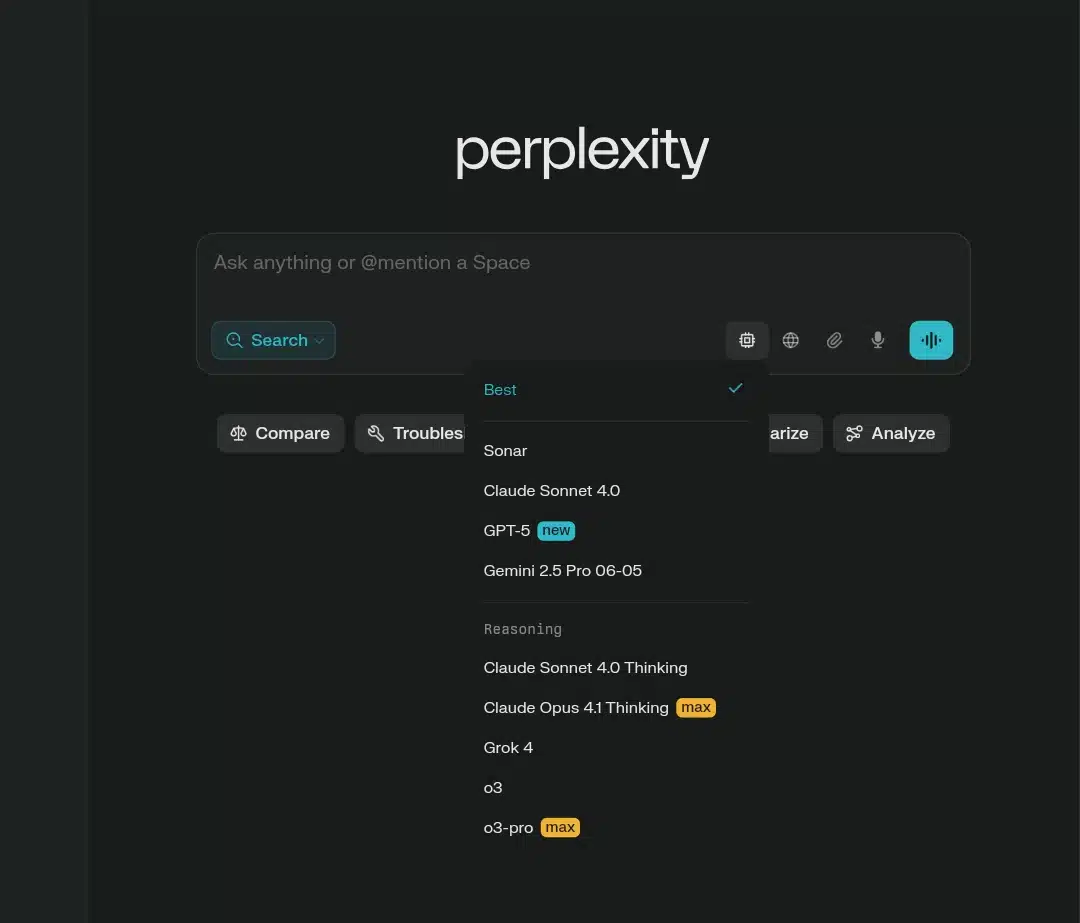
Perplexity AI is a conversational large language model (LLM) advanced chatbot for text-based tasks. It has quickly become popular due to its strong performance and ability to provide transparent answers with proper citations, making it especially useful for individuals who require reliable sources when writing, researching, or teaching.
Many people describe it as “a new Google,” but that’s not entirely accurate. It doesn’t replace Google, but it does something Google doesn’t: it brings you direct, well-sourced answers instead of just links. This makes it very effective when you don’t want to spend time digging through websites yourself. For example, if you’re preparing a paper or report, you can ask Perplexity to research a topic, and it will summarize key information with relevant sources you can check.
Beyond research, it can also handle general Q&A, explanations, and learning support. It’s available on the web, iOS, and Android mobile apps, and recently, it has been integrated into platforms like X (formerly Twitter) and WhatsApp. This means you can chat with it almost anywhere, similar to how Meta AI works on WhatsApp or Grok AI works on X.
What makes Perplexity AI unique?
Let’s look into Perplexity AI’s features, then:
Deep Research
The Deep Research functionality is perhaps Perplexity AI’s most impressive capability. This feature transforms complex research tasks by autonomously conducting multiple searches, analyzing hundreds of sources, and producing structured, comprehensive reports. Whether you’re conducting market analysis, product research, or financial investigations, this tool can eliminate hours of manual work by handling the entire research pipeline from initial planning through final synthesis.
Flexible AI model integration
Perplexity Pro subscribers gain access to cutting-edge AI models, including GPT-5, Claude 4.0 Sonnet, and Gemini 2.5 Pro, alongside Perplexity’s proprietary Sonar model. This flexibility lets you select the most appropriate AI system based on its specific requirements, whether prioritizing reasoning depth, response style, or processing speed.
Advanced source management
The platform’s source control capabilities provide unprecedented flexibility in information gathering. You can constrain searches to specific websites, combine organizational files with web content, or focus exclusively on particular source types. This feature proves invaluable for maintaining compliance requirements and ensuring research reproducibility, which is particularly valuable for enterprise applications.
Creative image generation
Beyond text-based research, Perplexity AI incorporates native image generation and editing capabilities. You can create visual content directly within their research workflows, with free accounts receiving limited access while Pro subscribers enjoy expanded generation privileges.
Perplexity Pages
Perplexity Pages enables you to convert research threads into polished, shareable content formats. This feature transforms raw research into structured articles or guides while maintaining proper source attribution, making it ideal for creating presentations, stakeholder reports, or public-facing explanations.
Threads
The platform’s threading system allows you to organize research into logical groupings through Spaces and Collections. This organizational structure supports complex, multi-faceted research projects while enabling consistent instructions and scope management across related queries.
Academic focus
Recognizing the importance of scholarly research, Perplexity AI offers specialized academic modes that prioritize peer-reviewed literature and reputable journals. This feature proves invaluable for researchers, students, and professionals requiring citations from authoritative academic sources.
Financial market integration
The Finance experience caters specifically to market research needs, offering features like Earnings Hubs, price alerts, and automated watchlist summaries. These capabilities position Perplexity AI as a lightweight research terminal for anyone requiring both market data and contextual analysis.
E-commerce integration
Perplexity AI’s shopping features represent an innovative expansion beyond traditional research applications. The “Buy with Pro” functionality enables U.S.-based Pro subscribers to complete purchases directly within the platform using saved payment and shipping information. The complementary “Snap to Shop” feature utilizes visual search technology, allowing users to photograph items and locate similar products with integrated purchasing options.
Transparent Source attribution
Perhaps most importantly, Perplexity AI maintains consistent citation practices with always-visible source references. You can expand footnotes, navigate directly to source materials, and continue conversations while maintaining clear connections to factual origins. This transparency represents a core differentiator in the platform’s “answer engine” abilities.
Moving on to DeepSeek, now.
What is DeepSeek?
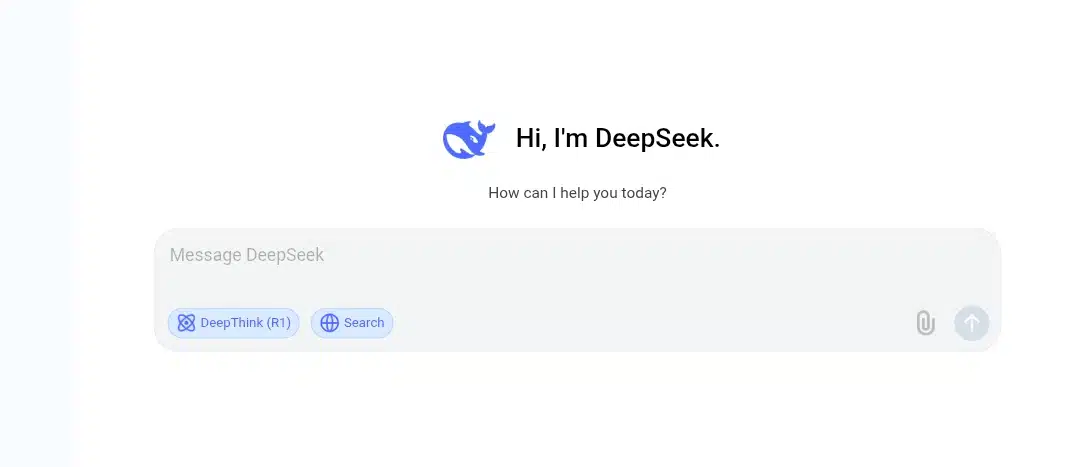
DeepSeek is a Chinese artificial intelligence startup founded in 2023 and headquartered in Hangzhou. Its founder and CEO, Liang Wenfeng, also co-founded the quantitative hedge fund High-Flyer, which supports DeepSeek’s growth through funding and infrastructure.
The company gained global attention in 2025 with the release of its DeepSeek-R1 model and chatbot. The launch immediately drove widespread adoption due to its performance, quickly overtaking ChatGPT on Apple’s U.S. App Store —a rare achievement for a new entrant in the large language model space.
DeepSeek is valued for its focus on efficiency and accessibility. Models such as R1 and V3 have demonstrated GPT-4-level reasoning while being trained with fewer resources, relying on clusters of NVIDIA H800 GPUs. This cost-efficient approach makes the models attractive to both researchers and developers.
The chatbot is available as both a web and mobile application on iOS and Android, expanding its reach to a global user base. So, what features does DeepSeek even have?
DeepSeek’s features
Free and unlimited access
DeepSeek Chat can be used without any subscription or hidden limits. You do not have to worry about running out of messages, hitting a cap, or being asked to upgrade after a few conversations. The service is available at no cost, and it is designed to remain free to use. For anyone who wants consistent access to an AI system without committing to a plan, this makes it easy to experiment, practice, or even rely on it for daily tasks without interruption.
Advanced AI performance
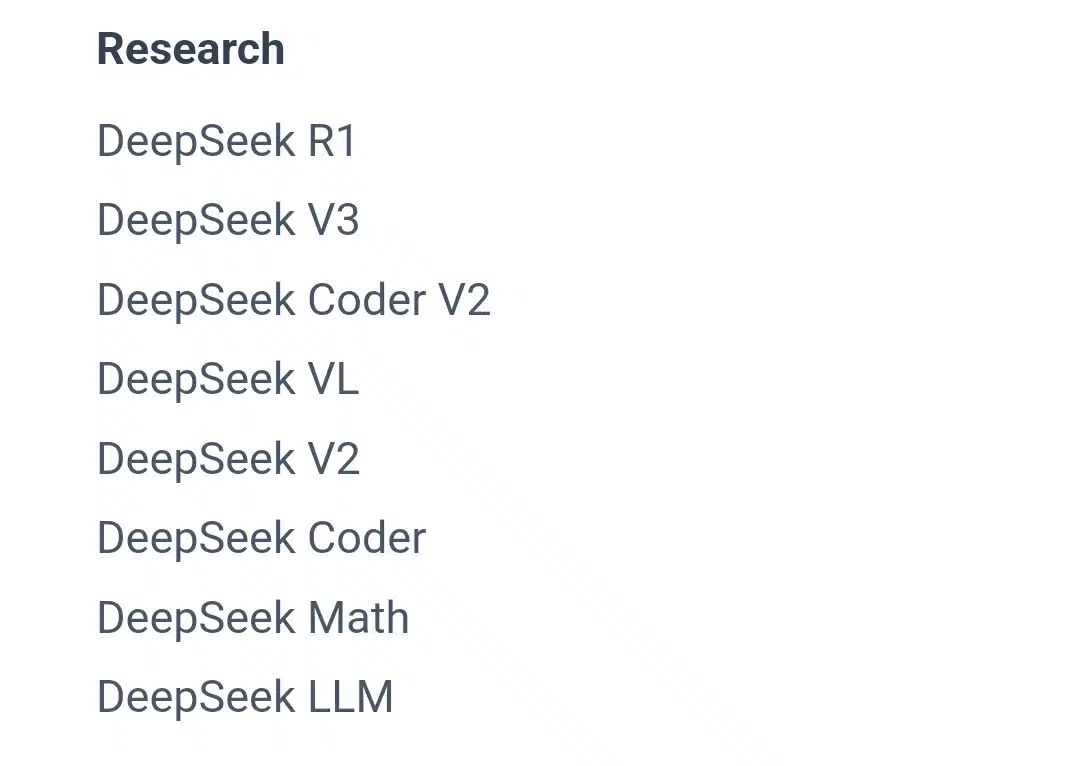
The system runs on large language models that perform at the level of GPT-4. This means it can handle complex prompts, remember context within a conversation, and generate detailed or creative answers across various topics. Users can expect the response quality associated with the best AI models currently available without needing a premium account. For research, writing assistance, coding help, or casual conversation, it can provide thoughtful output that aligns with what other top-tier chatbots offer.
Privacy and security
Conversations with DeepSeek are not stored on the company’s servers, and you are not required to provide personal information to start using it. This approach reduces many people’s concerns when trying out AI services, especially around data tracking and long-term storage of sensitive questions. Since no account is necessary, what you type stays between you and the system, giving you more privacy than platforms that log and keep chat history.
Simple access across devices
DeepSeek runs directly in a web browser, which removes the need for installation or registration. You can open it on a desktop computer, laptop, tablet, or smartphone, and the interface will automatically adapt to the screen size. This makes it practical for people who switch between devices throughout the day. You can quickly open a tab and begin typing without delays caused by downloads or login steps.
Multilingual capabilities
The chatbot is not limited to English language use. It supports communication in several major languages, including Spanish and Chinese, as well as many others. For people learning a new language, this can serve as a practice tool by asking questions or engaging in brief conversations. For those working with information written in another language, the system can help interpret or explain content. This makes the tool usable in different regions and contexts, rather than restricted to a single audience.
How did I use Perplexity AI and DeepSeek features in the test?
How I tested Perplexity AI and DeepSeek
I didn’t just decide on random prompts for them. However, I designed five specific prompts that address areas I (and, understandably, other users) care about when using an AI, such as staying updated on events, conducting academic-style research, generating creative writing, solving math or science problems, and assisting with coding. Each of these categories reveals a distinct aspect of the models, and together they provide a well-rounded picture.
Here are the exact prompts I used and why:
1. Current Events
“Summarize the three most significant global economic developments from the past seven days, with verifiable sources. For each development, explain why it matters to everyday people and cite where the information comes from.”
Why? I used this to see whether each AI could handle real-time awareness, citations, and everyday clarity. If a model couldn’t connect current news to real human impact, it’d lose value quickly.
2. Academic-Style Research
“Discuss how magical realism as a literary style has been used differently in Latin American and African literature. Include references to at least two scholarly analyses.”
Why? I wanted to test an AI’s depth of knowledge and scholarly accuracy. It’s easy for an AI to sound smart, but I needed to see if it could engage with fundamental research in a way that academic writing entails.
3. Creative Writing
“Write the opening scene of a short story where a city wakes up one morning to find every piece of digital technology has stopped working. Focus on human reactions and atmosphere rather than action. Keep it under 250 words.”
Why? This prompt let me measure creativity, control, and tone. I wanted to know how each AI could stay focused on the mood and theme I asked for without drifting off into clichés.
4. Math & Science Problem-Solving
“Solve this problem step by step: A satellite orbits Earth at an altitude of 500 km. Estimate its orbital period using basic physics (assume Earth’s radius is 6,371 km and gravitational constant GM = 3.986 × 10^14 m³/s²). Show your reasoning clearly, not just the final number.”
Why? For me, this is a test of numerical reasoning and step-by-step clarity. I wasn’t just looking for the correct number but also for how the AI could guide me through the logic.
5. Coding Assistance
“Write a Python function that takes a list of integers and returns all pairs of numbers whose sum equals 100. Optimize it for readability, and then explain how the algorithm scales with larger lists.”
Finally, I tested programming support. I wanted to see whether the AI could produce clean, functional code while explaining the Big-O complexity.
Let’s see the actual results below.
Testing Perplexity AI vs DeepSeek on 5 similar prompts
Let’s get straight into it:
Perplexity AI and DeepSeek performance on Economic News
When I asked both AI assistants about the three most significant global economic developments of the past seven days, I witnessed a fascinating head-to-head comparison that really showcased their different strengths.
Perplexity AI’s performance:
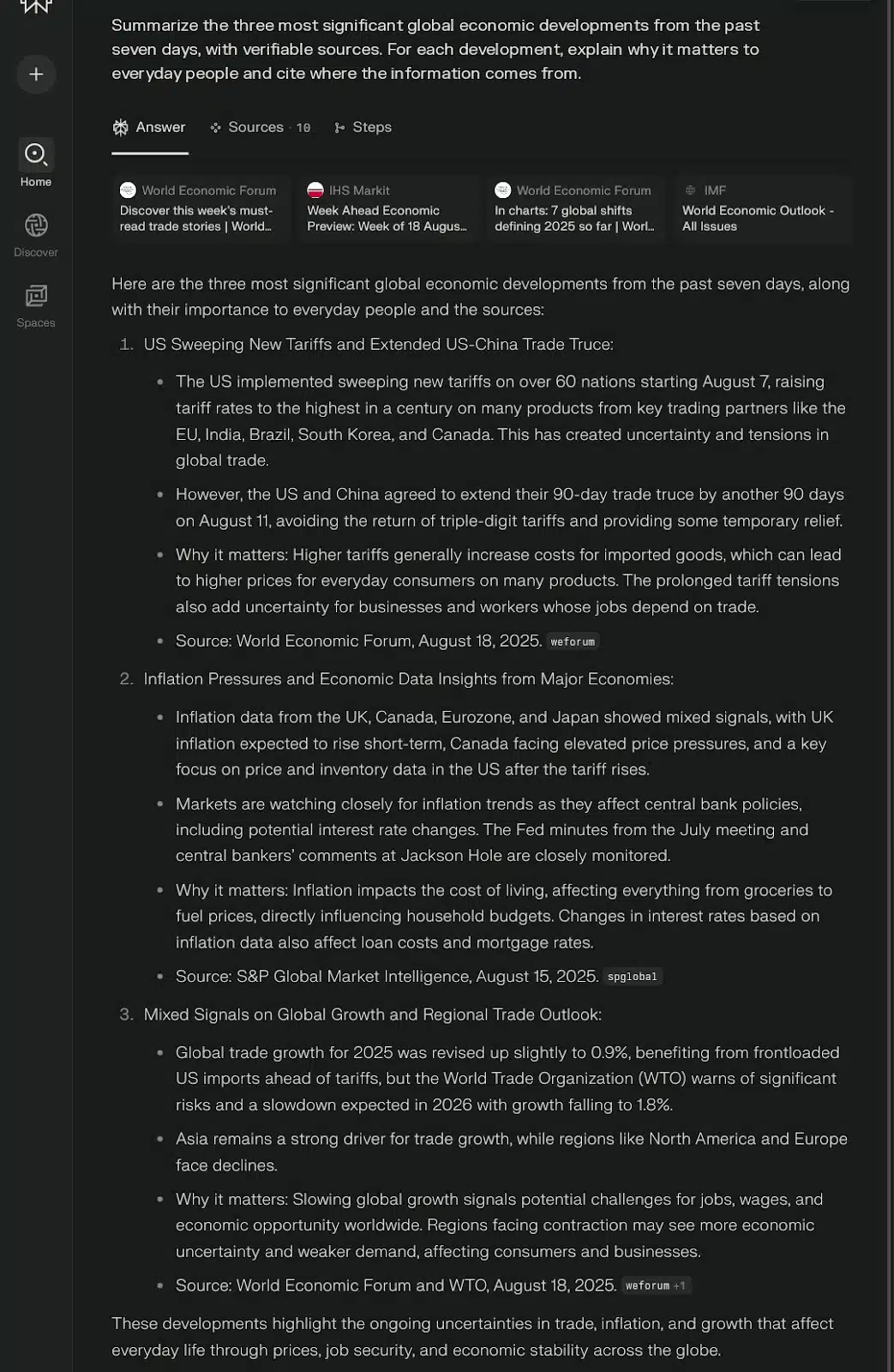
I have to say, Perplexity AI delivered precisely what I was looking for with impressive speed and clarity. Within seconds, I received a well-structured response that hit all my requirements perfectly. The response covered:
- US-China Trade Relations: I got precise details about new tariffs on 60+ nations AND the extended 90-day trade truce
- Global Inflation Pressures: I saw mixed signals from the UK, Canada, the Eurozone, and Japan, with explanations I could actually understand about central bank implications
- Trade Growth Projections: I received updated forecasts that made sense of the global economic landscape
Perplexity AI didn’t just dump economic jargon on me. When I read about the tariff situation, I immediately understood how higher import costs would hit my wallet through consumer prices. The inflation analysis is connected directly to my household budget and potential loan rates. This wasn’t dry academic content; I was getting practical, actionable information that actually mattered to my daily life.
The source integration felt seamless to me. Each central point came with proper attribution from credible outlets like the World Economic Forum, S&P Global Market Intelligence, and the WTO. I could see exactly where each piece of information originated, which gave me confidence in what I was reading.
DeepSeek’s performance
DeepSeek took a completely different approach that honestly blew me away with its depth. I received what felt like a professional economic briefing with:
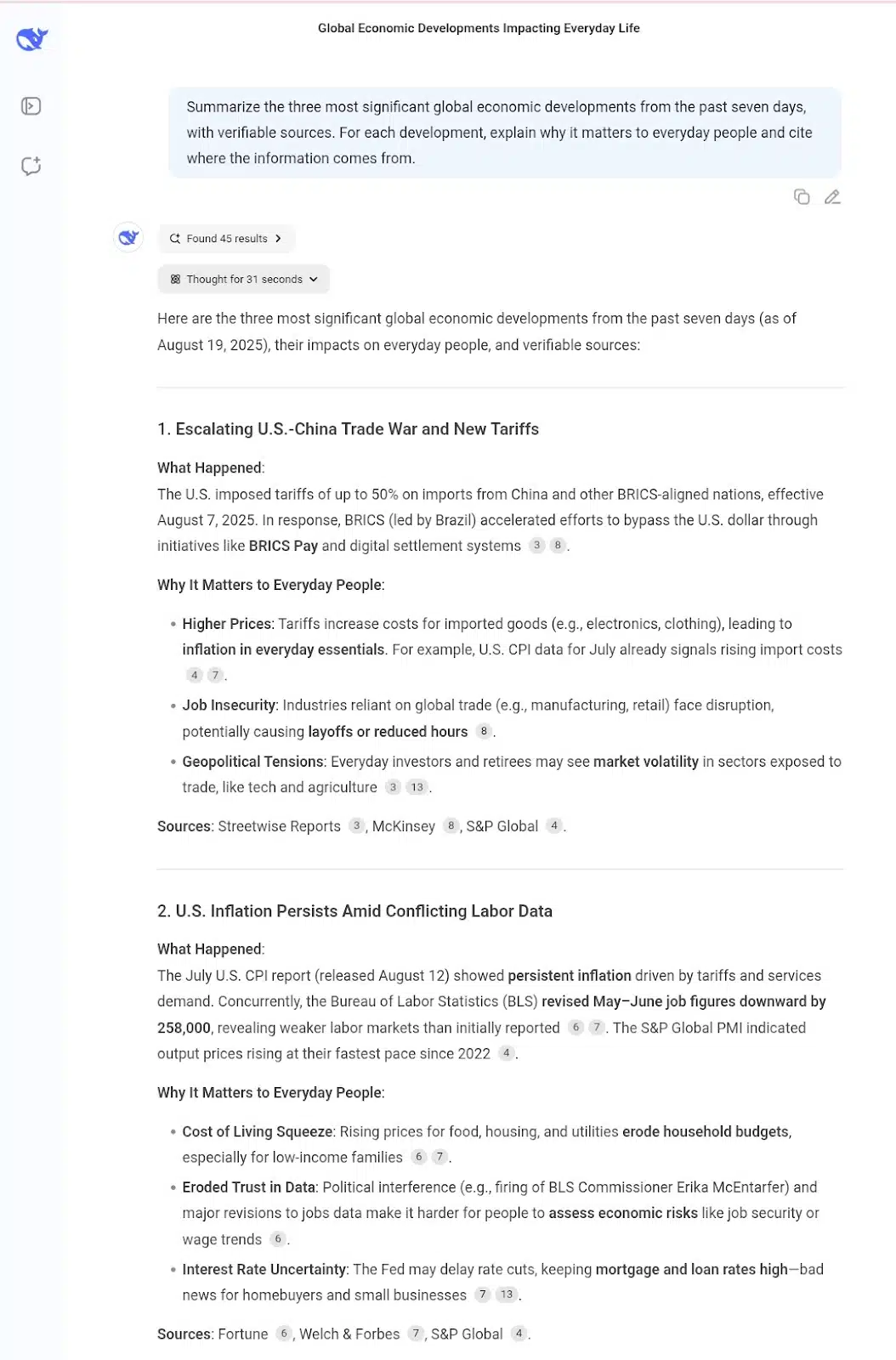
- Escalating US-China Trade War: I got specific details about 50% tariffs and BRICS payment systems – information that felt more current and detailed
- US Inflation Persistence: I saw concrete data like the 258,000 job revision and S&P PMI indicators that Perplexity missed
- IMF Growth Revisions: I received the exact 3.0% forecast update with specific warnings about “moneyquake” disruptions
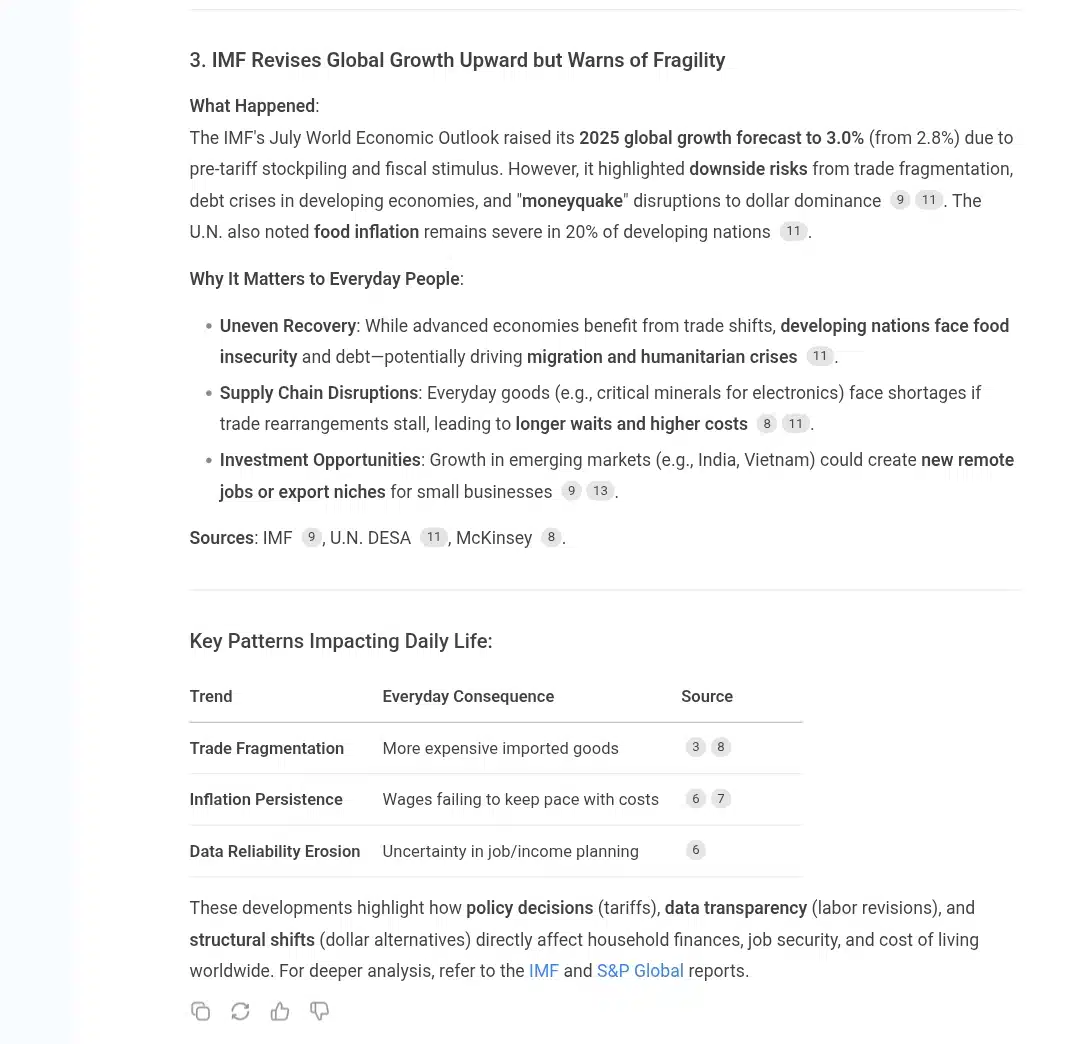
What really caught my attention was DeepSeek’s use of numbered inline citations throughout the entire response. I felt like I was reading a research report where I could track every claim back to its source. The summary table at the end was brilliant – I could see at a glance how “Trade Fragmentation” leads to “More expensive imported goods” and how “Data Reliability Erosion” creates “Uncertainty in job/income planning.”
If I needed a quick, reliable overview for a general understanding, I’d choose Perplexity. But if I were making investment decisions or needed to brief others on economic trends, DeepSeek’s depth and analytical structure would be my go-to. Both delivered on my requirements, but DeepSeek went several steps further in providing actionable intelligence I could actually use.
Perplexity AI vs DeepSeek performance on Academic Research
Both tools handled the magical realism literature question well, but in distinctly different ways, highlighting their core strengths.
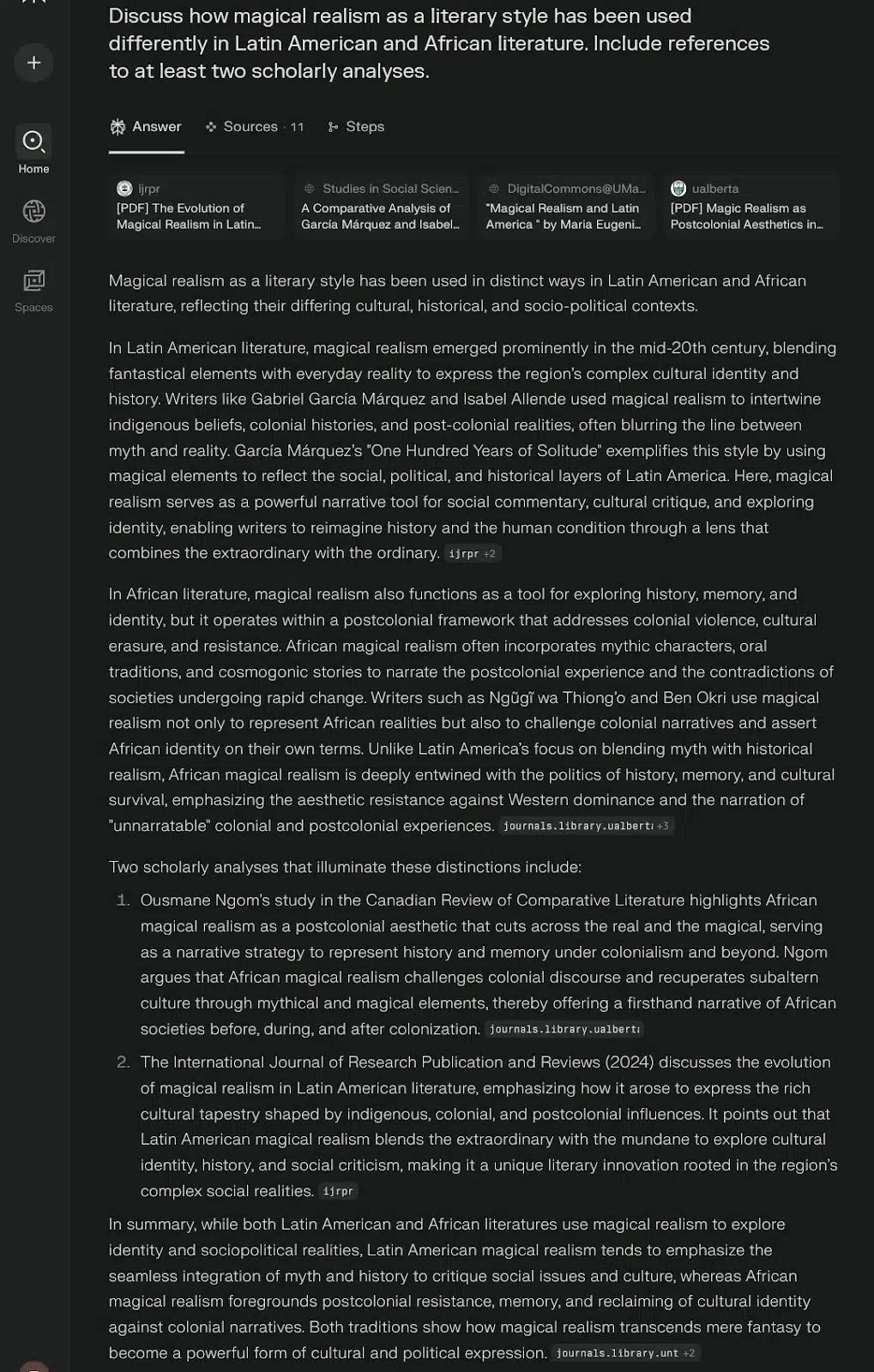
Perplexity’s approach was efficient and source-driven. It found relevant academic papers quickly (11 sources) and provided a solid comparative analysis. The response covered both Latin American and African traditions with proper scholarly citations, including specific journal references like the Canadian Review of Comparative Literature.
DeepSeek’s method was more like reading an actual academic paper. It took much longer, but it provided a deeper cultural and historical context. DeepSeek explained the postcolonial framework for African magical realism and the indigenous influences in Latin American works with more nuanced analysis.
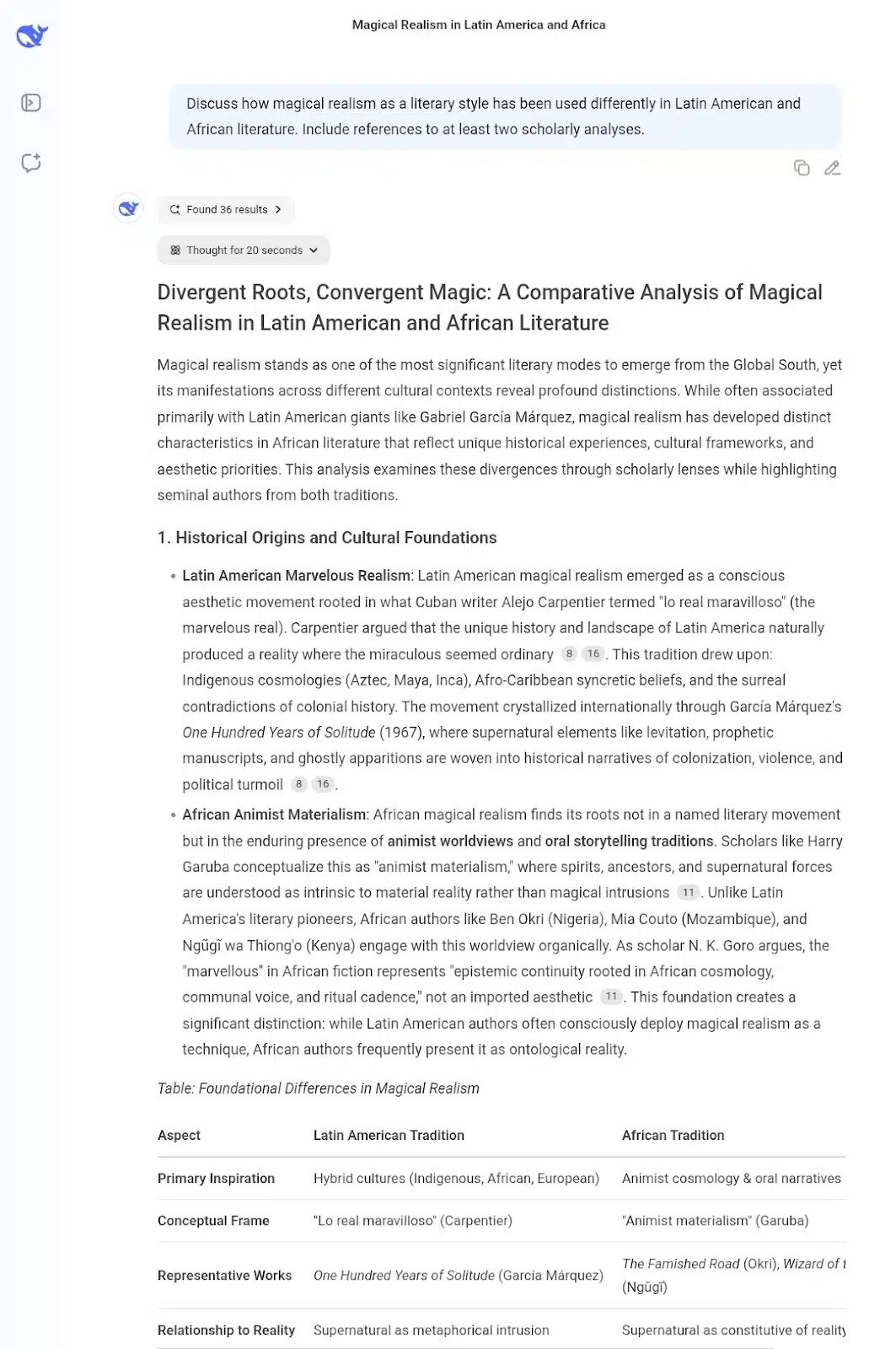
But it didn’t have a good academic writing tone and style like Perplexity AI. Plus, its citations were just recycled from a few sources. I wanted it to branch out.
Perplexity wins for academic research where you need quick, properly cited information. For a deeper understanding and learning of the subject matter, DeepSeek’s thoroughness is valuable.
The Math problem test
This really showed the difference between them. I gave both the same satellite orbital period calculation. Perplexity gave me the correct answer with some basic steps. But DeepSeek? It spent over 400 seconds thinking, then laid out every single calculation step by step. I could see precisely how it converted units, calculated each part of the formula, and even showed me different ways to get to the final answer.
Perplexity’s math solution was clean and organized. It broke down the problem into clear steps, showed all the formulas, and provided the calculation methodology in a structured format. The final answer (94.4 minutes) was correct, and the explanation included verification that this matches expected orbital periods for low Earth orbit satellites.
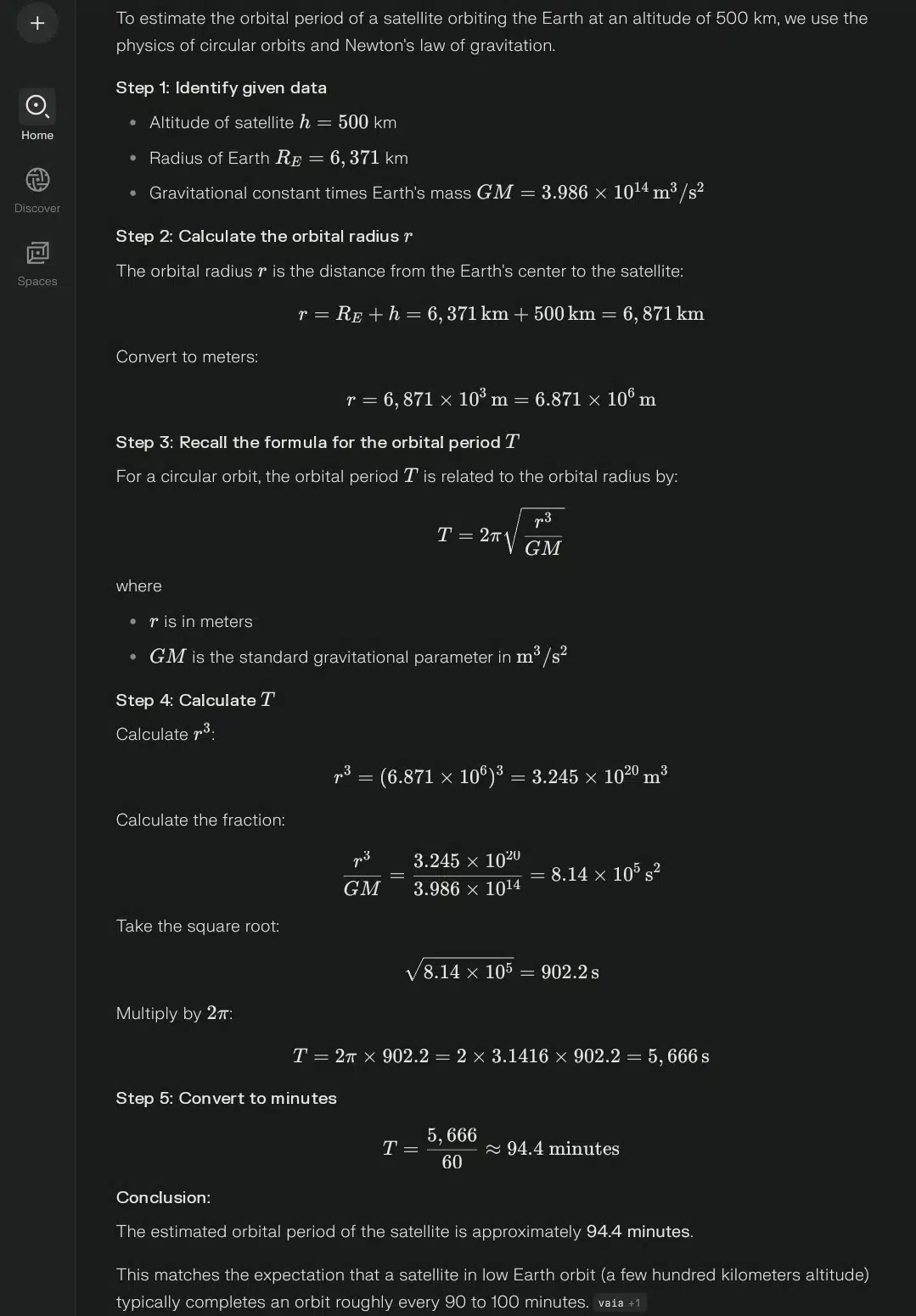
What I appreciated about Perplexity’s math approach was the clarity of presentation and the practical context it provided at the end. However, it felt more like following a textbook solution.
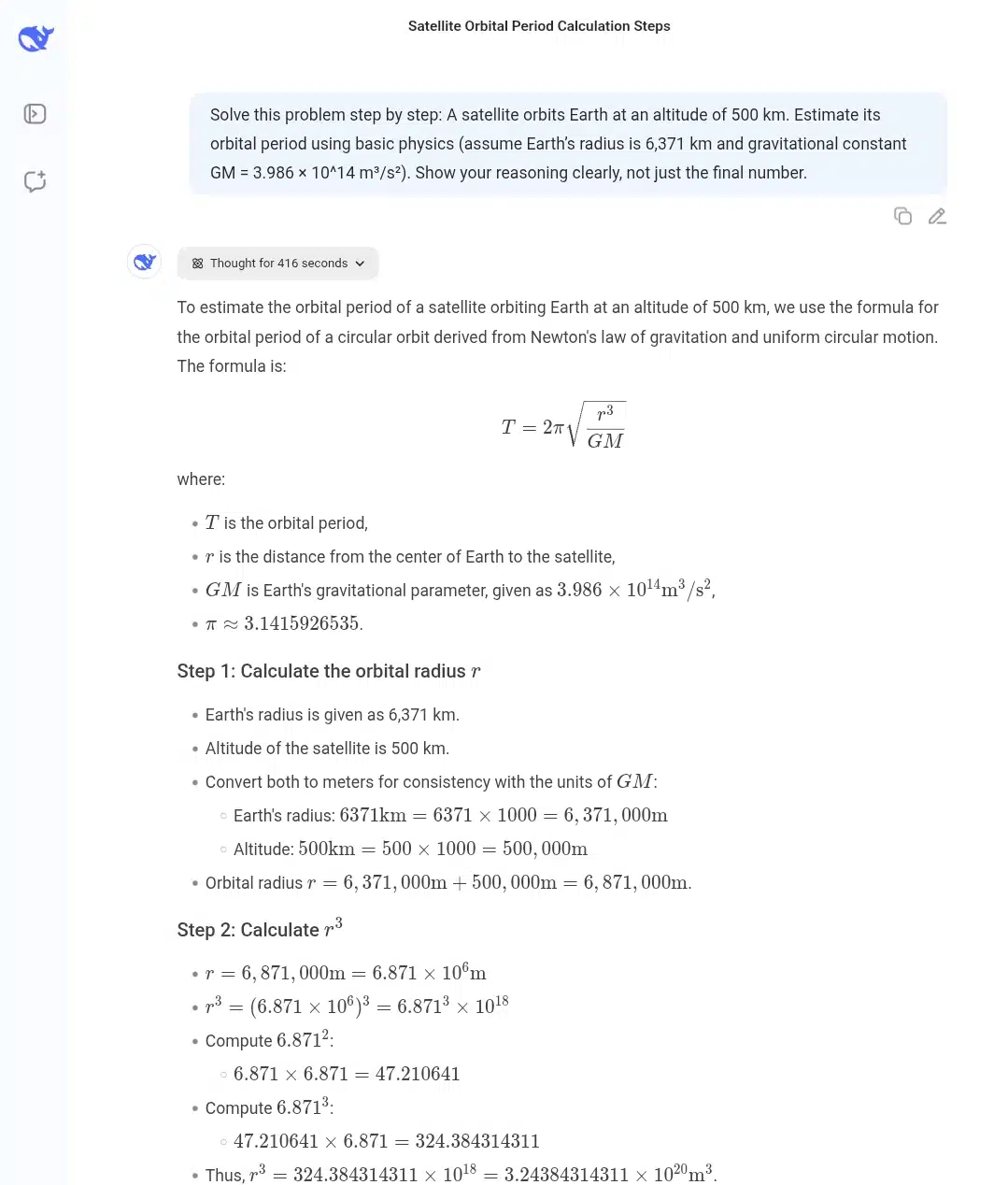
DeepSeek’s approach is gold for someone learning. I could follow along and actually understand the physics behind the calculation.
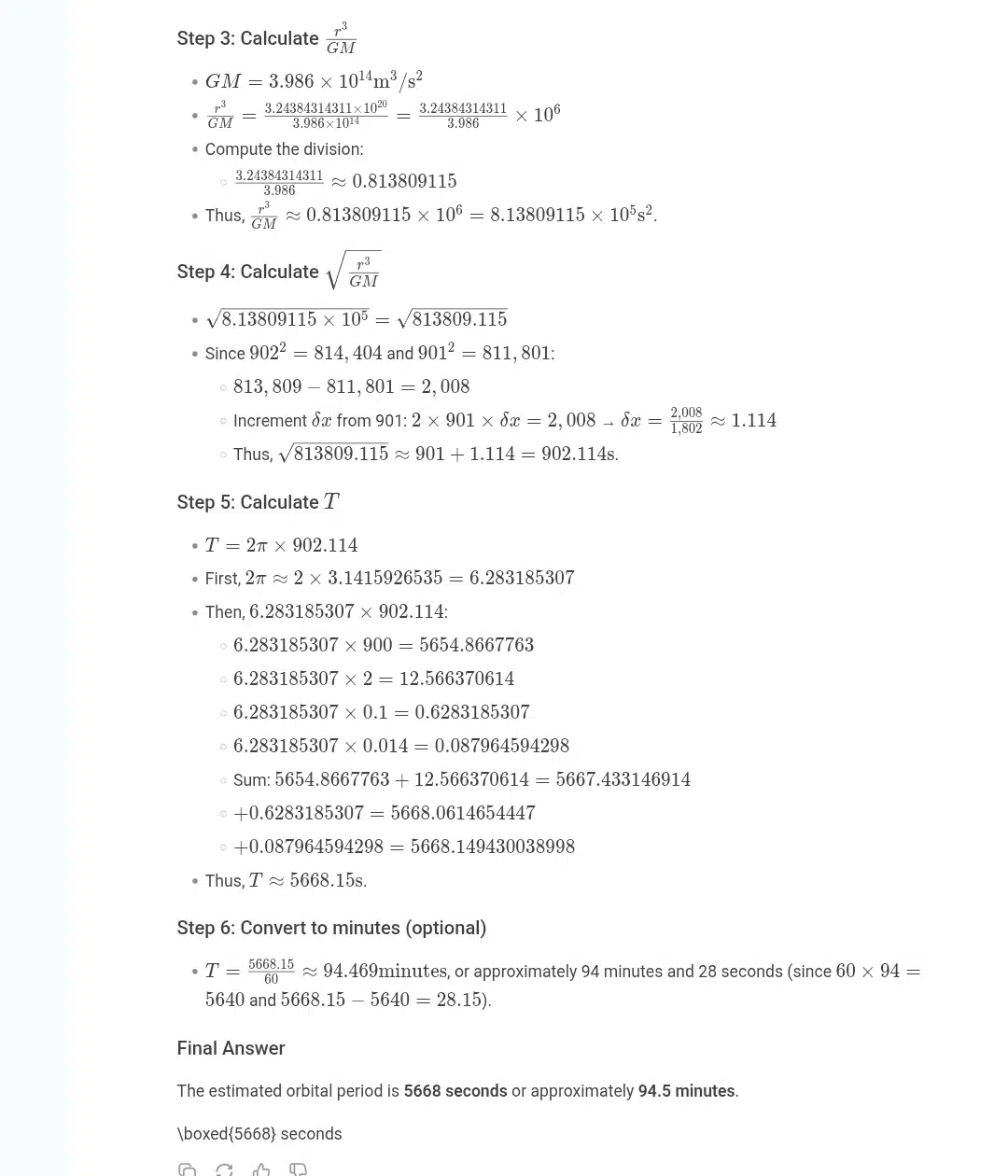
I got the answer with Perplexity, but I wouldn’t know how to solve a similar problem on my own.
Creative Writing: Totally different styles
When I asked both to write the opening of a story about a city where all technology stops working, the results were night and day.
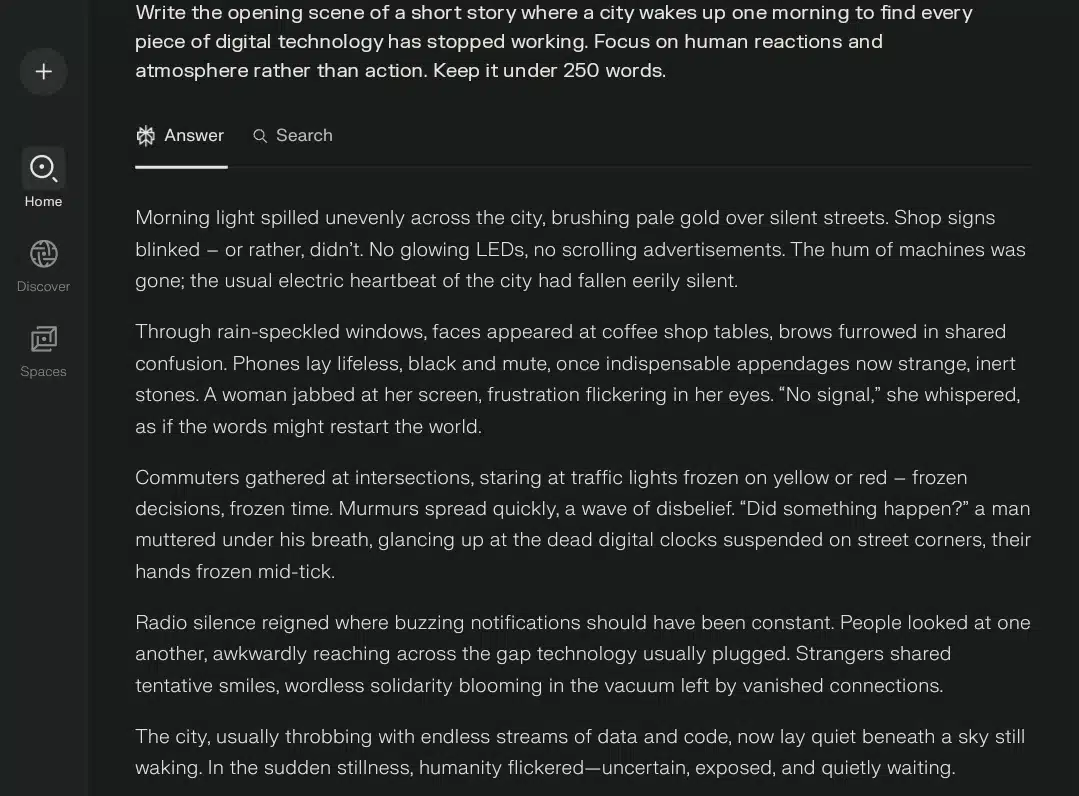
Perplexity’s creative writing was immediate and atmospheric. The story opened with vivid imagery: “Morning light spilled unevenly across the city, brushing pale gold over silent streets. Shop signs blinked—or rather, didn’t.” The writing was a bit evocative, effectively capturing the eerie stillness.
The narrative had good pacing and strong visual elements. Perplexity created compelling scenes like commuters staring at frozen traffic lights and people reaching tentatively across the technological void. The ending was particularly striking: “The city, usually throbbing with endless streams of data and code, now lay quiet beneath a sky still waking.”
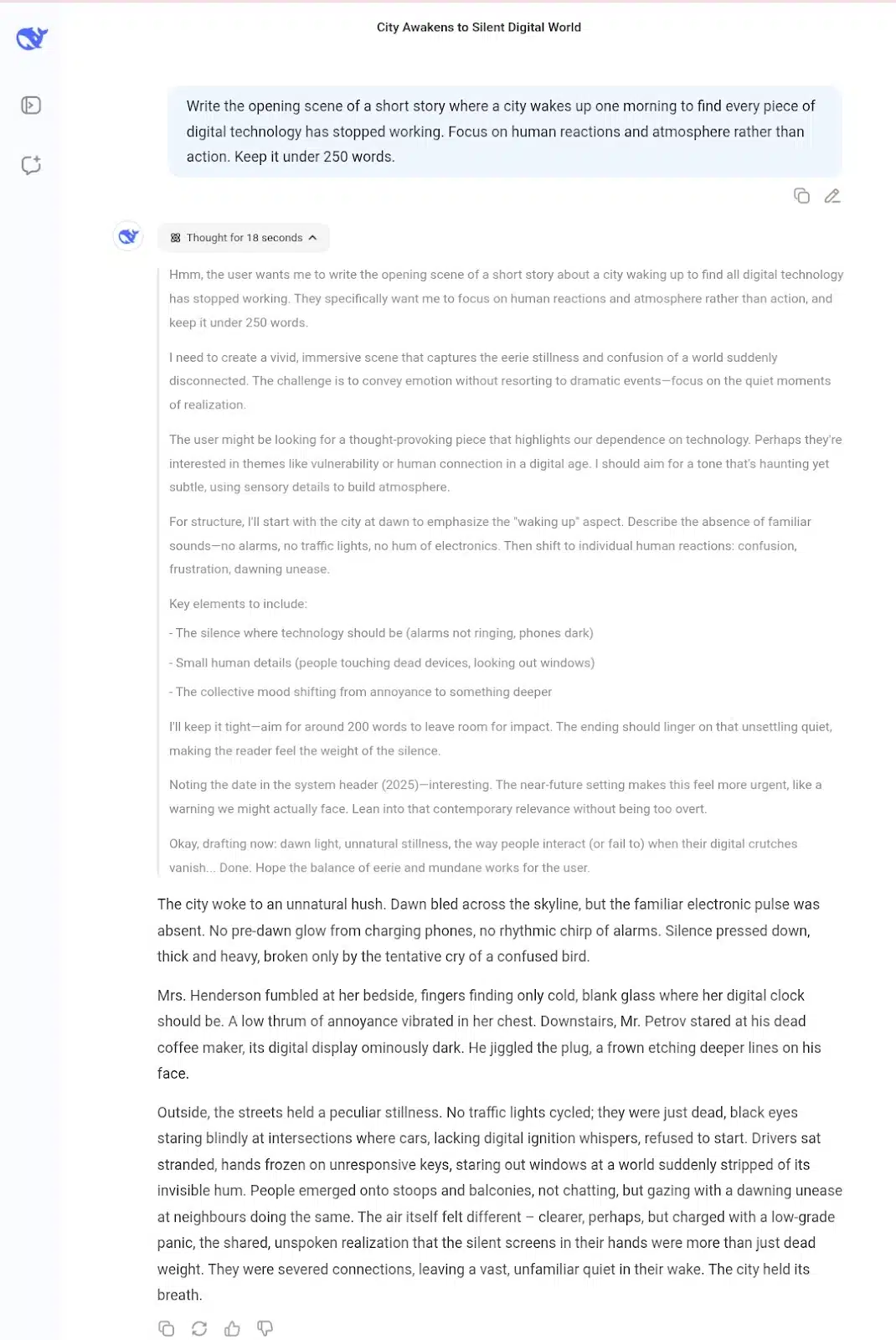
DeepSeek actually planned out the story first – I could see it thinking about atmosphere, character reactions, and how to structure the scene. Then it wrote this detailed piece that captured the eerie feeling I sought. The writing felt more thoughtful and layered. And it has a named character, not the unnamed ones Perplexity AI gave.
Both delivered quality results in creative writing, but Perplexity’s speed advantage is significant here.
Coding: Both good, but had different focuses
Both handled the Python coding task well, but their approaches reflected their core philosophies.
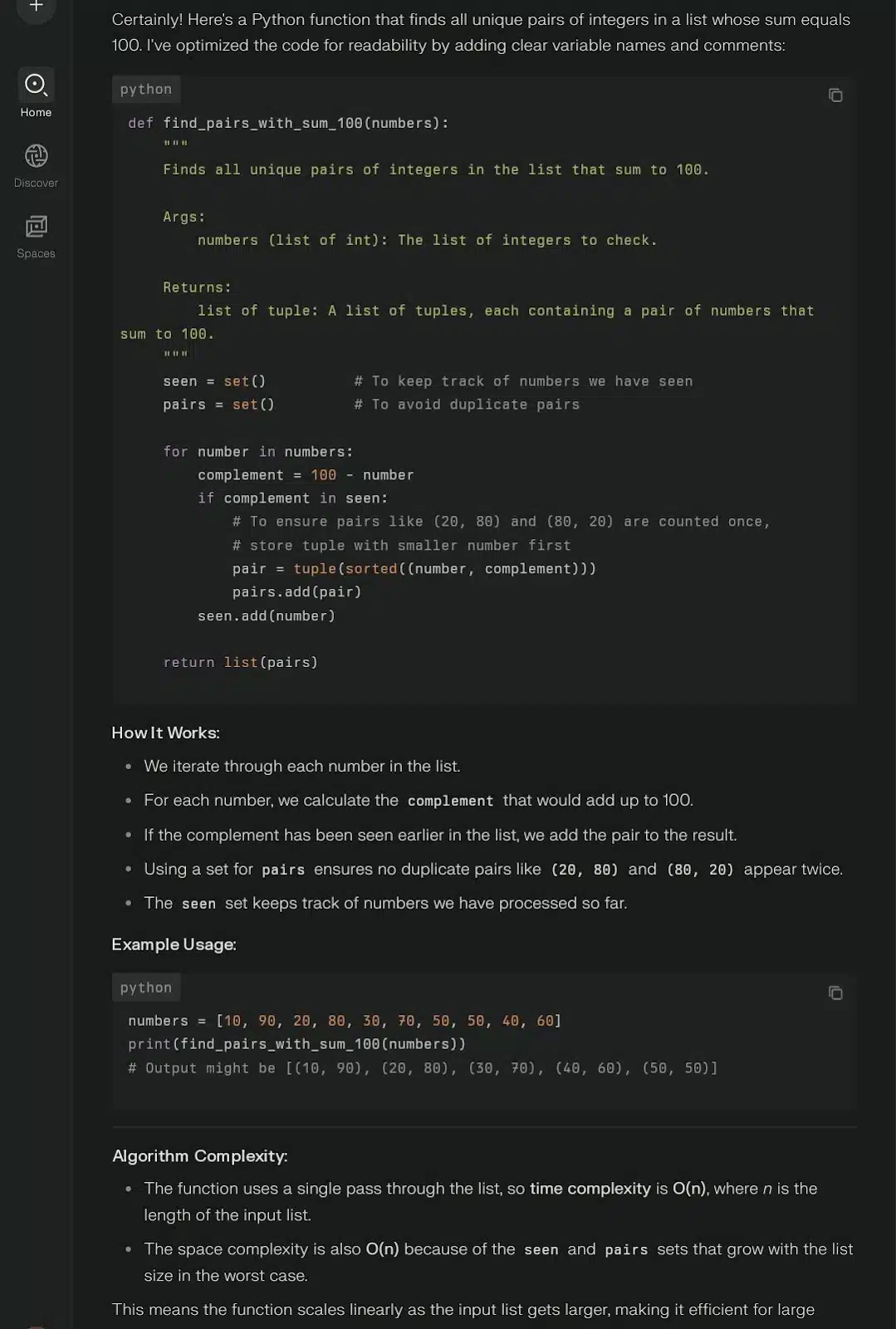
Perplexity’s coding solution was immediately practical. It provided clean, optimized code with clear variable names and comprehensive comments. The function included:
- Proper documentation with docstrings
- Efficient algorithm using sets to avoid duplicates
- Clear explanation of time and space complexity (O(n))
- Example usage with expected output
- Explanation of how the algorithm works step-by-step
The code was production-ready, with good practices like using sets to track seen numbers and avoiding duplicate pairs. Perplexity also provided complexity analysis, noting that both time and space complexity scale linearly with input size.
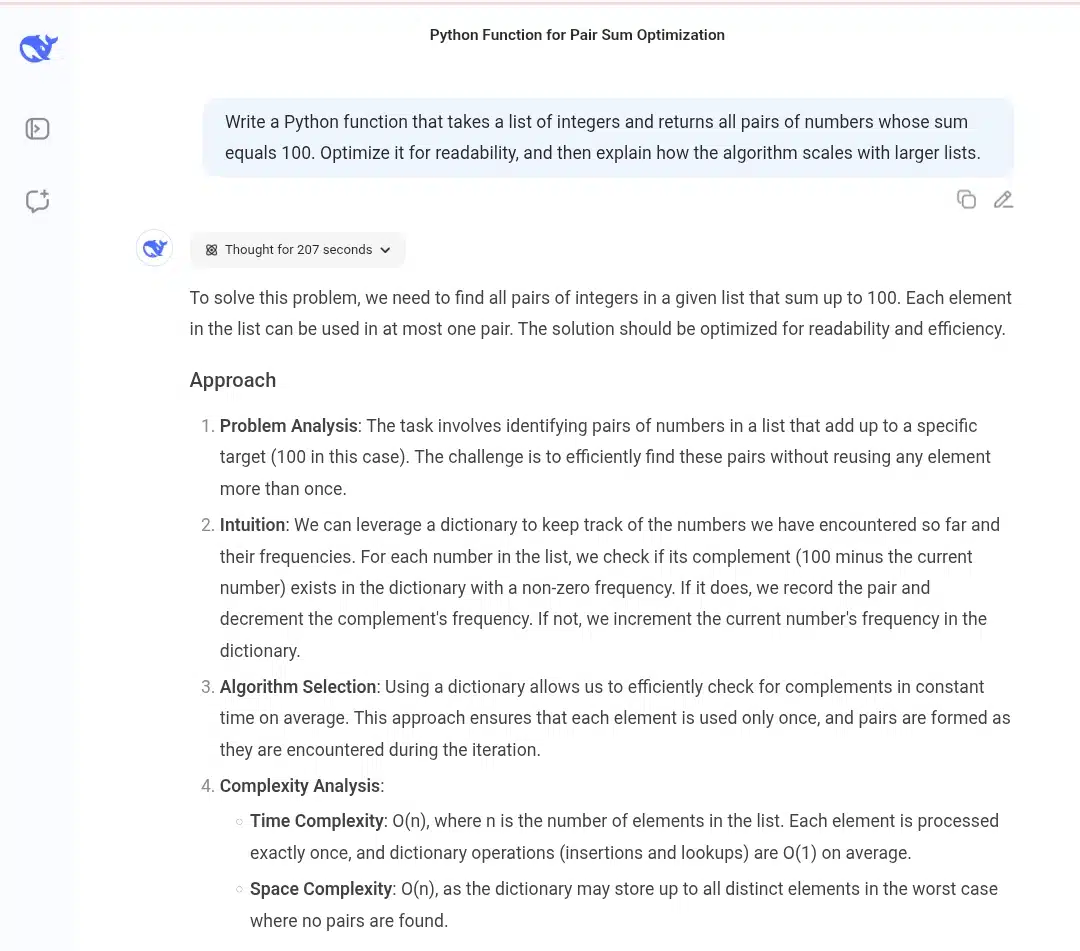
DeepSeek went further. First, it explained the problem, walked through different approaches, and then provided the code with detailed comments and a thorough explanation of why each part works.
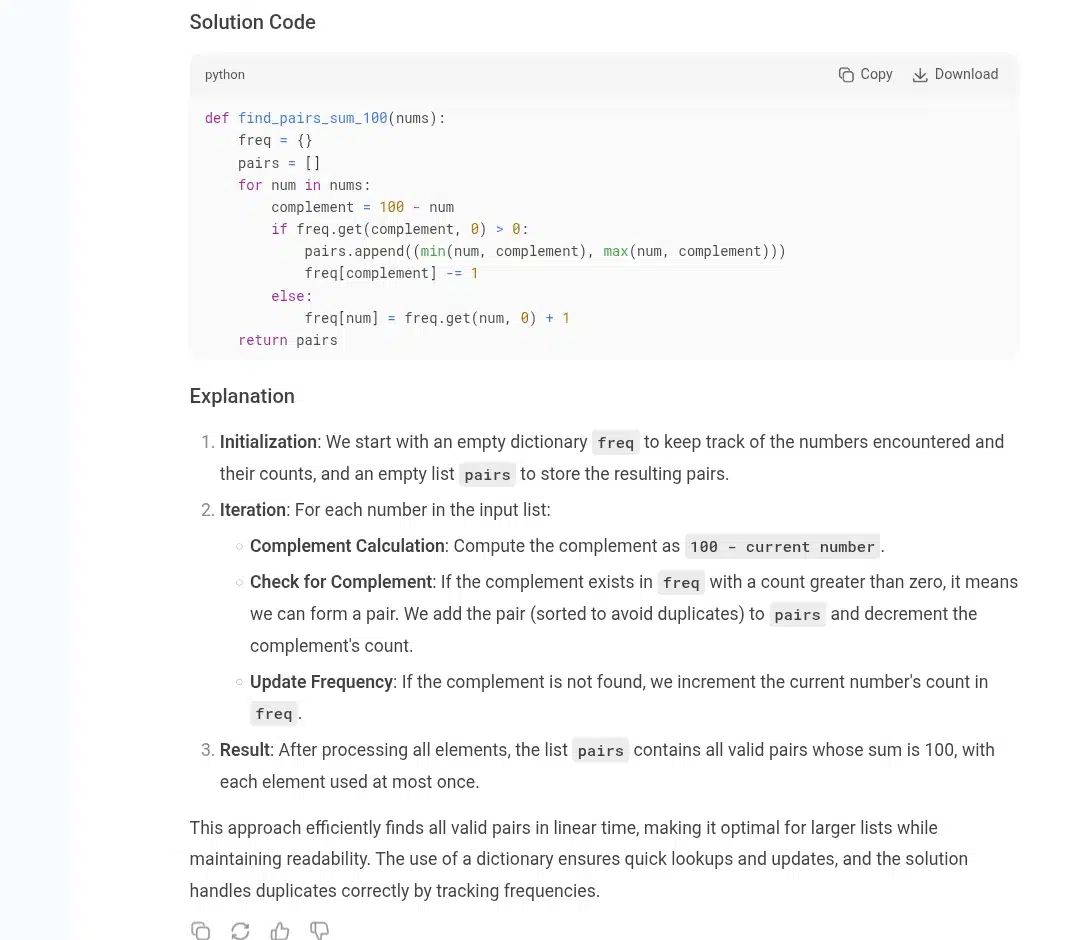
If you’re learning to code, DeepSeek’s approach teaches you more.
For coding tasks, Perplexity provides immediately usable, well-documented solutions. DeepSeek offers more educational value but takes significantly longer. So, let’s move forward to my likes and dislikes during this testing.
Pros and Cons of Perplexity AI
Pros
Perplexity AI excels for researchers who need to quickly gather sources and structure seminar papers, final year projects, or proposals.
It saves developers time by providing extra coding assistance, debugging support, and reference material in one place.
Mathematics tutors benefit from their ability to explain formulas, solve equations, and provide step-by-step breakdowns that can be shown to students.
Financial marketers can use it to analyze trends, summarize reports, and reframe complex data into marketing-friendly formats.
Content writers who produce articles in bulk can rely on the efficient web-linked responses to build outlines and draft text with less manual research.
Cons
Creative writers cannot rely on it for character creation because its breakdowns feel logical but lack emotional realism.
Screenwriters find the dialogue generation too stiff, producing lines that feel mechanical and unnatural for human delivery.
Graphic designers gain little value since their image generation is limited and lacks the realism and versatility of tools like Canva or MidJourney.
Perplexity struggles with open-ended storytelling, often giving summaries instead of immersive narratives.
Pros and Cons of DeepSeek AI
Pros
Fiction writers can use their “thinking process” outputs as raw material to build realistic characters with depth and nuance.
Students can ask it to think through problems step by step, gaining insights into problem-solving approaches instead of just final answers.
Inexperienced coders can use it as a supportive tool for debugging, explaining errors, and learning new programming patterns.
Cons
DeepSeek’s structured reasoning is less sound for writers who need fluid storytelling rather than logical scaffolding.
Its character suggestions can feel overly analytical, requiring heavy human editing before they become believable.
Screenwriters still cannot rely on it for authentic dialogue since its responses lean toward explanation instead of conversation.
It does not integrate seamlessly with design or media workflows, making it unsuitable for visual creatives.
Beginners who expect ready-made answers might find its reasoning chains overwhelming and slower than other LLMs’ direct solutions.
Less precise in fact-checking or academic queries than Perplexity AI’s.
With these strengths and limitations, who is Perplexity AI and DeepSeek suitable for and not?
Who should use Perplexity AI?
Using Perplexity AI has made its ideal users crystal clear to me. These are the groups I believe would get the most out of its abilities:
Researchers who need to write seminar papers, final year projects, or proposals
Perplexity AI is well-suited for academic researchers and students who are handling major writing tasks. It provides fast access to verified sources, structured summaries, and citations that can be directly integrated into research papers. Its ability to condense complex materials into manageable insights saves significant time for final-year projects or proposals. Instead of manually combing through journals and articles, users can rely on Perplexity’s retrieval abilities to generate drafts, which they can later refine. This makes it a valuable tool for meeting academic deadlines without sacrificing quality.
Developers who need extra coding assistance
Developers benefit from Perplexity AI’s support in coding and debugging. It can explain programming concepts, suggest code snippets, and point to relevant technical documentation. While it may not fully replace a dedicated coding assistant like GitHub Copilot, it works well as a complementary tool for general-purpose queries. A developer building prototypes, testing algorithms, or troubleshooting common issues will find it reliable for quick answers. Its ability to merge explanations with source links also ensures the user can cross-check rather than rely unthinkingly on output.
Mathematics tutors and students
Perplexity AI can help both mathematics tutors and learners who deal with problem-solving daily. It handles explanations of formulas, step-by-step breakdowns of equations, and contextual learning aids. It can be a fast way for tutors to prepare examples or clarify teaching methods. It offers an on-demand reference for students, making practicing mathematics less daunting. While it may not always handle complex symbolic computation at the level of Wolfram Alpha, it gives clear, structured reasoning that supports learning.
Financial marketers
Perplexity AI can serve as a research partner in fields such as finance and marketing, gathering insights across various industries and consumer data. Marketers can query it for market trends, competitor activities, or economic updates, and receive consolidated results instead of browsing scattered sources. Financial professionals benefit from its concise summaries of lengthy reports, allowing faster decision-making. For presentations or client updates, this saves hours of background preparation. Its grounding in sourced material also reduces the risk of unverified claims, which is critical in financial communication.
Content writers who produce in bulk
Writers who generate high volumes of articles can use Perplexity AI to streamline topic research and outline preparation. It excels in gathering key points from across the web, saving writers the time it takes to compile references manually. Instead of spending hours on background research, they can start drafting faster, using Perplexity’s summaries as a foundation. While it won’t produce polished creative text, it provides the raw material needed to keep up with heavy workloads. This efficiency is a significant advantage for large teams or freelancers under deadlines.
Who wouldn’t like Perplexity AI?
Here’s the other side of the coin: these people will find it really frustrating using Perplexity AI for the following tasks:
Creative writers who need help brainstorming characters and plots
Creative writers may find Perplexity AI limiting because its strengths lie in factual retrieval, not imagination. While it can describe narrative structures or explain storytelling principles, it cannot generate unique, believable characters convincingly. Its suggestions often feel stiff, lacking personality and realism. Writers looking to co-create fictional worlds or brainstorm original plotlines will not get the kind of flexible, imaginative support that tools like ChatGPT or Sudowrite provide.
Screenwriters who would love to roleplay dialogues
Perplexity AI struggles with producing human-like dialogues that screenwriters require. It prioritizes factual clarity over conversational flow, which results in flat or mechanical lines. Roleplay and improvisation (skills vital for building dynamic scripts) are not its design focus. Screenwriters exploring character interaction or testing emotional pacing will find Perplexity unable to meet their needs. Other generative models tuned for creativity provide far more natural exchanges.
Graphic designers
Although Perplexity AI recently added limited image generation, it is not a strong choice for graphic designers. The outputs lack the polish, range, and adaptability of established platforms like Canva, MidJourney, or Adobe Firefly. Perplexity falls short for professionals who need layered editing, brand alignment, and stylistic flexibility. It remains primarily a text-driven tool, not a design suite. Designers will find greater creative freedom with dedicated design platforms built around visuals rather than factual answers.
Who should use DeepSeek?
The most realistic way to identify who should or should not use DeepSeek is to focus less on broad categories like “developers” or “designers” and more on the actual needs, limitations, and risks involved. Not every user would benefit equally; in some cases, relying on DeepSeek may even be counterproductive. Let’s see what I mean.
Ideal users include:
People who cannot afford paid AI tools or are skeptical of paying
DeepSeek is most valuable to people who want the capabilities of an AI chatbot but cannot afford to pay subscription fees. It allows them to test prompts, explore ideas, and complete basic tasks without financial commitment. For individuals who can pay but are skeptical about whether it’s a good investment, Deepseek throws the doors open for their practical entry point into AI use.
Content Writers
Writers focusing on blogs, articles, or general content creation can use DeepSeek to speed up drafting. While the results should never be published raw (since the language quality often leans toward being overly verbose or flowery), the tool can produce outlines, expand sections, or brainstorm alternatives that the writer can later refine.
Story Writers and Fiction Creators
One strength of DeepSeek lies in its structured “thinking” process. When prompted to analyze or break down an idea, it tends to provide a chain of helpful reasoning for creative development. Story writers can ask it to map out traits for a fictional character, explore possible conflicts, or outline motivations. Instead of copying its prose, they can use the logical unfolding it provides as a foundation for more realistic and imaginative characters.
Experienced and new Coders
Coders who know their way around programming languages can use DeepSeek to generate snippets, test alternative solutions, or accelerate debugging because they can evaluate the correctness of the code and filter useful outputs from errors. New coders can use it, too, but they should pay more attention to GitHub Copilot and others since they wouldn’t know if DeepSeek’s output is correct or how to prompt it for a near-good result.
Who should not use DeepSeek:
Researchers
Researchers who need to produce academic papers, proposals, or project reports should avoid relying on DeepSeek. The tool tends to generate writing that is verbose, poorly structured, and not suited for scholarly work. Its inability to handle precise research standards makes it unreliable in academic contexts.
Healthcare professionals and medical researchers
Using DeepSeek in healthcare is risky and strongly discouraged. Medical knowledge requires precision, verified data, and alignment with textbooks or peer-reviewed journals. AI-generated content cannot substitute for this level of authority. Human expertise and reliable references are essential for health, safety, and treatment.
Scriptwriters
Scriptwriters, in particular, should not depend on DeepSeek. The dialogue it generates is typically stiff and unconvincing, lacking the natural flow of real conversation. Instead, scriptwriters should draft their own dialogues based on the story’s theme and test them by having human readers act them out. This human evaluation ensures the dialogues sound realistic and emotionally authentic, something DeepSeek cannot replicate.
Now, what is the price behind Perplexity AI and DeepSeek?
Perplexity AI and DeepSeek’s pricing
Perplexity AI operates on a tiered, freemium model designed to suit a range of users from casual searchers to enterprise teams.
Free Tier
Perplexity offers a usable entry point for casual users or those just exploring AI-assisted search. While limited, the Free tier gives access to the core answer engine, although advanced features like high-volume searches, full model access, and unlimited file uploads are reserved for paid plans.
Pro Plan ($20/month or $200/year)
- The Pro plan unlocks Perplexity’s full potential:
- Unlimited Pro searches, typically providing hundreds of daily uses.
- Access to advanced models like GPT-4.1, Claude 4.0, Grok 4, Gemini Pro 2.5, and in-house models like Sonar and R1-1776.
- Extended capabilities: file uploads, “Deep Research” auto-synthesis, image generation, API access, and enhanced support.
Promotions occasionally reduce costs further. For instance, Airtel India currently offers its users a one-year free Pro subscription, valued at approximately ₹17,000 (~USD 200).
Enterprise Pro ($40/user/month or $400/year)
- Suited for teams and organizations, Enterprise Pro offers:
- Flexible seat-based billing: $40/month or $400/year with a 20% annual discount.
- Scales for larger teams (250+ seats) with tailored pricing and onboarding.
- Enterprise-ready features: internal file search (up to 500 files), integrations (SSO, SCIM), audit logs, file retention controls, GDPR/HIPAA compliance, and secure admin access.
Startup Program
Startups raising under $20M and younger than 5 years may qualify for 6 months of free Enterprise Pro (up to 50 seats) and $5K in API credits. This is an attractive opportunity for early-stage teams.
DeepSeek’s primary offerings are broadly free and pay-per-use:
Free Access – Both the chat interface (V3) and reasoning model (R1) are unrestricted on web and mobile, with no subscription required.
DeepSeek’s API pricing has a token-based billing:
DeepSeek-V3 (Chat):
- Cache hit: ~$0.07 per million input tokens
- Cache miss: ~$0.27 per million input tokens
- Output tokens: ~$1.10 per million
DeepSeek-R1 (Reasoning):
- Cache hit: ~$0.14 per million input tokens
- Cache miss: ~$0.55 per million input tokens
- Output: ~$2.19 per million
Off-peak (UTC 16:30–00:30): Up to 50–75% discounts (input: ~$0.035; output: ~$0.55)
Finally, Perplexity AI vs Deepseek, which is the better LLM?
There’s no “better than LLM” title when it comes to Perplexity AI and DeepSeek. They couldn’t be when they have different features and perform differently to prompts.
There is only this: the pricing system is different. In Perplexity AI, you can use it for free, but not totally free, as the paid plans block free users from using all features. On the other hand, DeepSeek has an allowance for every feature but still supports an API token cost for those who play to that level of things.
Perplexity AI is king on speed, and DeepSeek is too, but on limited timeframes, which isn’t great for up-and-down usage. However, its thinking process is very invaluable, a feature Perplexity AI lacks. You get to see how DeepSeek understands your questions and intends to answer them, whereas Perplexity AI just shows the sources blipping and gives an answer.
On creative writing, Perplexity AI tries but doesn’t offer a near-great answer. While DeepSeek doesn’t guarantee 100% correctness, its transparent thinking can help you make things up on your own.
To wrap up, Perplexity AI and DeepSeek are meant for different moments, so choose their assistance based on this.
FAQs on Perplexity AI vs DeepSeek
1. Can Perplexity AI be cited in an academic paper?
- Perplexity AI pulls directly from sources and includes citations, but is not a primary source. Researchers should trace the cited materials and reference the original studies or articles instead of the AI platform.
2. How does DeepSeek’s reasoning differ from Perplexity’s?
- Perplexity emphasizes retrieval-augmented generation, blending search with answers. DeepSeek leans toward reasoning-driven outputs, often giving extended chains of logic before conclusions. The tradeoff is speed versus depth.
3. Are responses from Perplexity AI reproducible?
- Not always. Because results depend on both the model’s generation and live web retrieval, repeating the same query may yield slightly different outputs depending on available sources at that moment.
4. Does DeepSeek have web access like Perplexity?
- No. DeepSeek does not retrieve live information; it relies on its training data and reasoning patterns. This means it cannot fact-check against the most current web results as Perplexity can.
5. Which AI is more reliable for long-term projects?
- Perplexity is stronger for projects requiring constant updates and fact-checking, while DeepSeek may be more stable for theoretical or reasoning-heavy tasks where live information is not critical.
6. How do both platforms handle sensitive data?
- Perplexity’s web-linked design means user prompts may be logged to optimize search results. DeepSeek operates more like a traditional LLM, processing prompts internally. Neither should be treated as a secure repository for confidential material.
7. Can Perplexity AI replace a research database?
- No. Although it can guide researchers toward sources and offer summaries, databases like JSTOR or IEEE Xplore remain essential for peer-reviewed, authoritative material.
8. How do the mobile apps compare?
- Perplexity has a polished mobile app with citation visibility and voice search. DeepSeek does not currently offer the same mobile-native experience, which may limit on-the-go usage.
9. Do both tools allow API integration?
- Perplexity has begun rolling out enterprise and developer-focused integrations. DeepSeek remains limited in this area, offering less flexibility for embedding into external workflows.
10. How do they differ in handling ambiguous queries?
- Perplexity often asks clarifying questions or provides multiple source-backed answers. DeepSeek tends to generate a single, extended explanation that assumes one question interpretation.
11. Which tool is better for interdisciplinary research?
- Perplexity excels when you need to cross fields quickly with source links. DeepSeek may be more useful when diving deeply into a single domain requiring structured reasoning.
12. Will either replace traditional search engines?
- Unlikely. Perplexity is closest, but even it depends on traditional indexing. DeepSeek is designed more as a cognitive assistant than a search tool. Both are complements, not replacements.

